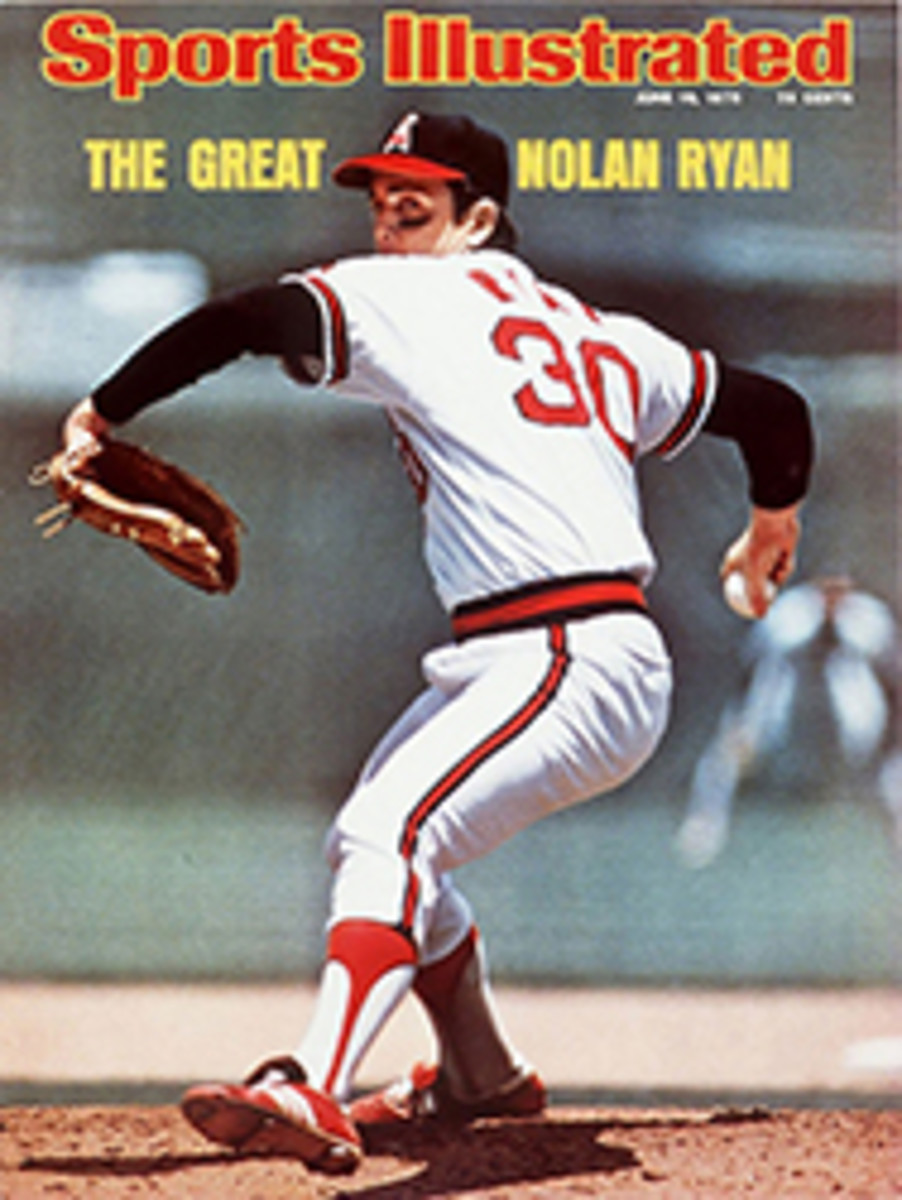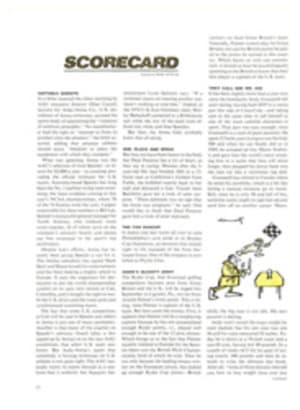
Three into 2 miles who go, go, go
Most interested parties, especially those living on the West Coast, are still shaking their stopwatches in disbelief. Track coaches and athletes from distance-running meccas such as Eugene, Ore. and Southern California cannot fathom how three high school two-milers from the state of Indiana—Hoosiers, for Pete's sake, who slosh through ice and snow half the year—could all have broken nine minutes in the same year. But such is the case. As of May 29, anyway, when Indiana had the No. I, the No. 2 and the No. 4 high school two-milers in the nation.
A closer look, and the real shock sets in: Rudy Chapa (1), Tim Keough (2) and Carey Pinkowski (4) are not merely from the same state—they attend the same school. They wear the purple and white of Hammond High, a school in the northwestern corner of the state that has no track of its own to serve perhaps the finest set of distance runners in prep history. Previously, no high school in the country had produced even a pair of sub-nine-minute two-mile teammates in one season. For three to turn up a few lockers apart, and in Indiana, is the stuff of which dreams are made.
Or nightmares, as Hammond High opponents might say. "Do I know who they are?" cried Tom Mather of West Lafayette, Ind. before a regional meet late last month. "Everybody here knows Pinkowski, Chapa and Keough. It can't be an accident that there are three of them in one place—they must have a good coach—but we're tired of losing to them. I'm not a bad two-miler myself; I won our sectional at home. Yet I'm 50 seconds slower than these guys."
Record keepers are similarly impressed. "More than 668,000 boys competed in high school track this year," says Jack Shepard of Track & Field News, "and nearly a million times were recorded for the two-mile alone. The fact that three runners from the same high school were in the top four in May is hard to accept."
Running more than 100 miles in training each week goes a long way toward explaining how Keough, Pinkowski and Chapa can produce times as good as or better than those of the best runners from more suitable climates. Surprisingly, the thousands of hours they have spent running together have not made them close friends. They are far too competitive and too divergent in personality and background.
Pinkowski, the rich-kid star of the trio (even though he was behind the others on that two-mile list), is a senior with such regard for his own ability as a storyteller that he records zingers on tape to delight Hammond High partygoers. With his new Buick Skyhawk ready for takeoff in the school parking lot and his shoulder-length hair and scruffy beard lookin' so right under a Dave Wottletype visor ("I wore this hat before Wottle made his famous"), Pinkowski is no shrinking violet.
He is no less impressive on the track, with an 8:56.2 clocking in the two-mile and a 4:12.4 mile. On May 1, when he ran the 8:56.2, it was the second-fastest time in the nation. However, Pinkowski was used more in the mile through much of the spring, and both Chapa and Keough, pushing each other hard, bettered his two-mile time.
Chapa, a junior "from Tacoville—way, way across the tracks," has to put up with being called "the nicest boy in school" by his teachers every time he turns around. When Chapa crossed the finish line early in May with Keough at his heels, he was timed in 8:52.6. Two weeks later, in the sectionals, he did 8:51 flat—then the fastest high school time this year. (On June 7 Eric Hulst ran 8:45 and Ralph Serna 8:46 in the California State Meet at San Diego. The high school record of 8:41 was set in 1973 by Craig Virgin of Lebanon, Ill.) Chapa also has run 4:11 in the mile, 12th nationally at the time.
Keough is a late-blooming senior who gave up football because he contracted an inflammatory condition involving his knees called Osgood-Schlatter disease. He moved along solidly but unspectacularly in the two-mile for a couple of years before suddenly exploding this spring. Between April 9 and May 3 he lowered his personal best from 9:25 to 8:52.8. No one seemed more surprised than Keough.
The city of Hammond is located 25 miles southeast of Chicago in "The Region," as the area is known by its down-state detractors. Surrounded by the steel mills of Gary and East Chicago and the oil refineries of Whiting, it is the kind of place that makes it difficult for a young runner to fantasize that he is really Jim Ryun making his way across a scenic Kansas plain. In winter, when Maywood Park, their most-favored running area, is covered with snow, Pinkowski, Chapa and Keough take to city streets that overflow with automobiles. During the "spring"—a fleeting phenomenon that lasts about three days in northern Indiana—the mercury may climb to 90° or stay down around 40°.
"How can I develop distance runners in this environment?" says Hammond High's 27-year-old coach, Dan Candia-no. "Well, the stress actually seems to strengthen our athletes, make them tougher. Besides, they know I'm gonna be out there running five or six miles with them every morning no matter what the weather. I think the only thing that ever stops us is lightning."
This 6 a.m. wake-up workout, combined with afternoon practice and meets, adds up to as many as 130 miles per week for each of Candiano's distance prodigies—a figure many college coaches feel is too high for a young body to handle. But Chapa, Pinkowski and Keough thrive on it. The morning before he ran his 8:51 in the sectionals, Chapa jogged from Hammond to Griffith, Ind. and back, maybe 15 miles in all. To "cool down" after the meet, Pinkowski and Keough ran home with him—another five miles.
"Oh yes, we run to other cities," Chapa says brightly, sounding like a Fred MacMurray ad for Greyhound. And Chapa has service home from other states as well. "Earlier this year I was disqualified from a race in Thornton, Ill. because I wore the wrong color shorts," he says. "I was pretty upset and I needed the mileage, so I skipped the team bus and ran back to school. I guess it must have been about 10 miles."
Such runners do not just happen. Back in 1972 Candiano heard Pinkowski making fun of a 4:19 mile Jim Ryun produced in a comeback attempt. Candiano dared Pinkowski to see how fast he could run a mile. Pinkowski admits he has not forgotten the horrors of his 6:19. But one year later he had run 4:19.3, and as he improved he set an example for Chapa, the little guy a year behind him in school. Soon the two of them were winning races from 880 yards to two miles, leading from start to finish and running away from all competition but themselves. To say they have been very nearly perfect during the last two seasons of cross-country and track is to take a shortcut through their press clippings:
•Pinkowski was undefeated over any distance above half a mile.
•Pinkowski set new course and meet records in 28 consecutive cross-country races.
•Chapa was undefeated in track and was beaten only once by someone other than Pinkowski in cross-country.
•Chapa was the first high school runner in Indiana history to break nine minutes for two miles.
•Pinkowski and Chapa created such a stir during last fall's cross-country season with their "co-championships"—intentionally running hand in hand across the finish line—that Indiana track officials said that henceforth teammates doing this would be disqualified.
In addition, Hammond High could have won the last two state track titles, if Indiana rules did not forbid distance men from running in more than one event. This was why Candiano shifted Pinkowski to the mile, leaving Chapa and Keough in the two-mile. Pinkowski bristles over that strategy. Neither was he happy with the hand-in-hand co-championships with Chapa—a piece of sportsmanship that was solely Candiano's idea. To alleviate the tension, Candiano thought of letting Pinkowski and Chapa go all out against each other this spring in what would have amounted to a match race, but the opportunity never arose.
"There's still no way to get a big head around here," says Pinkowski, whose laid-back cocky demeanor is mostly a front. "You can go out and run an eight-fifty-something, but you'll get no respect from our freshman runners. You come back afterward and they say, 'Nice race, Carey, but I could've kicked your butt.' "
Keough, somewhat in awe of his more accomplished teammates, says, "They are as dependable as the rising sun the way they win, win, win. They are always up there ahead of you—purple and white in the lead—pulling you along."
As usual, Pinkowski has to have the last word, possibly trying out a new routine before committing it to tape. "The three of us were running down the street just the other day," he says, with a glance toward Chapa and Keough to see if they are listening, "when this guy leans out of the window of his car and starts swearing at us. I let him have a few choice ones right back. You know what he does then? He jumps out of the car and tries to catch us. On foot! Can you imagine? He gave up after one block. He probably couldn't have caught us in his car."
PHOTO
HAMMOND HIGH'S REMARKABLE TRIO; RUDY CHAPA, TIM KEOUGH, CAREY PINKOWSKI

